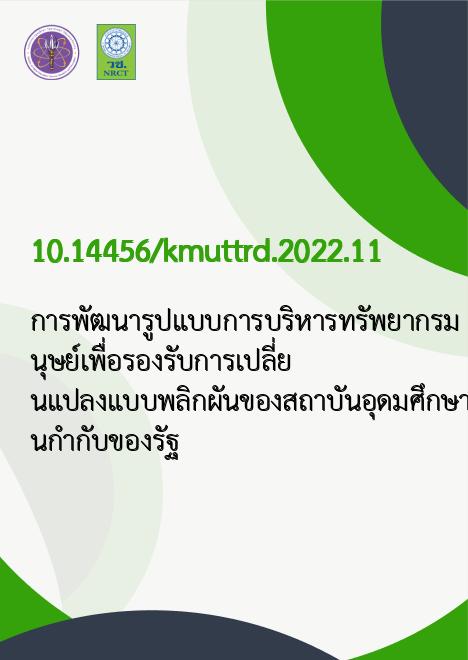
|
การพัฒนารูปแบบการบริหารทรัพยากรมนุษย์เพื่อรองรับการเปลี่ยนแปลงแบบพลิกผันของสถาบันอุดมศึกษาในกำกับของรัฐ |
|---|---|
| รหัสดีโอไอ | |
| Creator | อัมพร สงคศิริ |
| Title | การพัฒนารูปแบบการบริหารทรัพยากรมนุษย์เพื่อรองรับการเปลี่ยนแปลงแบบพลิกผันของสถาบันอุดมศึกษาในกำกับของรัฐ |
| Contributor | จักรกฤษณ์ โปณะทอง จตุพล ยงศร |
| Publisher | King Mongkut’s University of Technology Thonburi |
| Publication Year | 2565 |
| Journal Title | KMUTT Research and Development Journal |
| Journal Vol. | 45 |
| Journal No. | 2 |
| Page no. | 193-214 |
| Keyword | Human Resource Management, Higher Education Institution, Confirmatory Factor Analysis |
| URL Website | https://journal.kmutt.ac.th/ |
| Website title | เว็บไซต์วารสารวิจัยและพัฒนา มจธ. |
| ISSN | 2697-5521 |
| Abstract | This research aimed at the following objectives: 1) analyzing the human resource management component responding to disruptive changes of autonomous higher education institutions, and 2) developing the human resource management model responding to disruptive changes of autonomous higher education institutions. The research consisted of three phases. The first phase aimed to conduct a confirmatory factor analysis. In the first step, an interview of four experts as key informants chosen by a purposive selection was carried out. Seven interview questions were used to collect the data which was then analyzed by a content analysis. In the second step, by using a stratified random sampling method and a convenience sampling, the samples included 423 academic staff of four autonomous universities. A 5-rating scale questionnaire was used as an instrument to elicit the data which was then analyzed by descriptive statistics and a structural equation model. The second phase aimed to develop the Human Resource Management Model. The samples were seven experts chosen by a purposive selection. The drafted model was used as an instrument in a focus group meeting. A content analysis was applied to analyze and synthesize the received data. The third phase aimed to assess the appropriateness of the finalized model. The samples consisted of 75 academic staff through a purposive selection. The data were collected by using a 5-rating scale questionnaire, and analyzed by using frequency, percentage, mean, and standard deviation. An appropriateness criterion was applied using a one sample t-test technique. The findings revealed as follows: A) the Human Resource Management Components consisted of eight factors including 1) Strategic Analysis of Job and Business, 2) Manpower Optimization, 3) Talent Attraction, 4) Capability Enhancement, 5) Performance Management, 6) Reward and Recognition Management, 7) Employee Relations Management, and 8) HR Digital Savvy. The adjusted structural equation model was congruent with the empirical data (X2/df = 1.63, GFI = 0.90, CFI = 1.00, RMSEA = 0.038, SRMR = 0.025). B) the Human Resource Management Model comprised of eight components and 28 driving mechanisms. The developed model was appropriate at high level (Mean = 4.40, S.D. = 0.71), and its appropriateness level were higher than the criteria which was 3.51 at statistically significant level of 0.05 (t = 10.857, p = 0.000). Further recommendation and implication were also discussed. |